Учебное пособие Астрономия. Космическая техника и технологии Алматы, 2012 удк 802. 0 52 629. 7 (0758) ббк 81. Англ. 923
 Скачать 1.02 Mb. Скачать 1.02 Mb.
|
|
Listening “Why Do the Planets Orbit the Sun?” You are going to listen to New Millennium Program. Dr. Marc Rayman, a scientist at the Jet Propulsion Laboratory answers questions from our Space Place museum partners across the nation. Answer the questions: 1) Why do the planets orbit the Sun? 2) But if the Sun is pulling the planets, why don't they just fall into the Sun and burn up? 3) So is this sideways motion partly why we need rockets to launch a spacecraft into orbit? 4) Why do some spacecraft fly close to Jupiter when it isn’t even close to their destination? 5) So isn’t there any other way to make spacecraft go faster? Can’t we just “step on the gas” a little more? Unit 4 Constellations Text 4A The Mighty Hunter in the Winter Sky By Shannon Jackson I'd like to introduce you to one of my special friends. I only see him in the winter—and only when the sky is clear of clouds. He is a mighty hunter who has been placed in the w 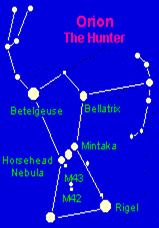 inter sky with his faithful dogs Canis Major and Canis Minor. Orion and his dogs hunt animals that have been placed nearby in the night sky, like Lepus, the rabbit and Taurus, the bull. inter sky with his faithful dogs Canis Major and Canis Minor. Orion and his dogs hunt animals that have been placed nearby in the night sky, like Lepus, the rabbit and Taurus, the bull.There are several stories about this beautiful constellation, but the one I like best is from Greek mythology. This tale has Orion in love with Merope, one of the Seven Sisters who form the Pleiades, but Merope would have nothing to do with him. Orion was killed when he was stung by Scorpius the scorpion. The gods felt sorry for him, though, and placed him in the sky with his two hunting dogs and the animals he liked best to hunt. They also put Scorpius in the sky—but placed him opposite in the sky so that neither would appear at the same time—and Orion would never be stung by Scorpius again. Orion is probably the second most recognizable pattern of stars in the sky (after the Big Dipper). Finding Orion in the winter sky should be no problem. Look towards the southern horizon for the three bright stars that make up Orion's belt (Alnitak, Alnilam, and Mintaka). The bright star that makes up his left shoulder is Betelgeuse. If Betelgeuse replaced our sun, its size would completely engulf the Earth and extend to Mars. There is an even brighter star in the opposite corner from Betelgeuse, called Rigel. This star is Orion's right knee. Rigel is the brightest star in Orion, and in fact, is the seventh brightest star in the heavens. Orion is visible from late fall to early spring. When you find Orion, see if you can locate his bow to the right and his raised arm and club to the left. Once you find him, it's fun to try to find his companions—Lepus, Taurus, Canis Major, and Canis Minor. Pleiades is also nearby. Choose the correct answer: 1) You can see Orion a) in spring b) in summer c) in winter d) in autumn 2) Orion is the ___ most recognizable pattern of stars in the sky. a) first b) second c) third d) fourth 3) Name five constellations that are located close to Orion. 4) What should you look for when first trying to locate Orion? a) His club b) His belt c) His bow d) His left shoulder 5) What is the name of the brightest star in Orion? a) Betelgeuse b) Rigel c) Alnitak d) Alnilam Text 4 B Locating the Circumpolar Constellations By Shannon Jackson When you look up at the night sky, what do you see? People from many cultures have looked up at night and used the star groups or constellations as they are called, to tell stories. Simple shepherds more than 5,000 years ago had many stories about the stars and constellations—and they couldn't even read or write. Some of the names sound strange because we still use the names given long ago. Want to learn some tips on how to find some of these pictures in the sky? Five constellations are always in our northern sky. Other groupings appear seasonally, and then disappear as they fall below the horizon. There are five constellations, however, which seem to circle Polaris (po LAR us), also known as the North Star. The North Star always stays put while the other stars and constellations are moving. Polaris is marking the North Pole for you. Of eighty-eight constellations, five are circling the North Pole—so we say they are circumpolar (circling the pole). And because they are always in our night sky in the northern hemisphere, these five circumpolar are a good starting point in learning the constellations. 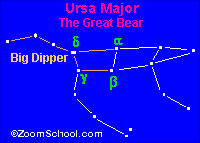 Choose a cloudless night. Begin your star connection with the most famous of all star pictures—Ursa Major, The Great Bear. Within this constellation is the Big Dipper. Some people think the Big Dipper is a constellation by itself—in fact; it is a part of this larger constellation Ursa Major. The Big Dipper will help find all of the other constellations. In the fall, look fairly low in the northern sky for a large dipper with a crooked handle, made up of seven bright stars. These stars make up the main body and tail of the Great Bear. This group of stars is the one picture that looks the most like its name. A dipper is something people used long ago when they would get water from a well or bucket. It is important to remember, the Big Dipper will not be in the same position throughout the year. As the seasons change, it rotates around the sky. In the fall it is full of water. In the winter it looks like an icicle with the handle hanging down, springtime has the Dipper letting the water "rain down on us," and summertime has the Dipper dipping into the bucket to get us a drink on hot days.  We can use the "pointer stars" of the bowl in the Big Dipper to find Polaris. Pass over the first star you come to and go to the star next in line. This will be Polaris. If you can find Polaris, then you can now find the Little Dipper. It is also made up of seven stars, with the handle bent opposite of the handle in the Big Dipper. Polaris is the last star in the tip of the handle. This is part of the constellation Ursa Minor. Continue in a straight line from Polaris to the tip of the next constellation, Cepheus (SEE fee us). He looks like a house, his pointed hat being the roof. He was an ancient king who played an important part in Greek mythology and the husband of Cassiopeia (cass ee oh PEE a). We'll meet her next. Cassiopeia is bright and easy to find in the sky. Sometimes she looks like W and sometimes like an M. Cassiopeia was ancient queen. This constellation, the Lady in the chair, is the second most easily found star picture in the sky. All of the five stars are almost the same brightness or magnitude. 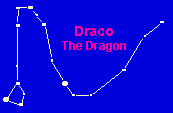 The fifth circumpolar constellation is Draco the Dragon. He is made up of faint stars, almost as if trying to conceal his presence as he lurks in the sky, ready to gobble up the king and queen. The easiest way to find Draco is to start with his tail. Go back to the star we skipped over when we were going from the Big Dipper to Polaris. That star is the tip of Draco's tail. He wraps around the Little Dipper. His head is a group of four stars that are directly in line with the bowl of the Little Dipper. There are fifteen stars in this constellation. Finding the five circumpolar constellations in the real sky can be a challenge—just remember to start with the Big Dipper and go from there. Before long you will be ready to tackle finding the rest of the eighty-eight constellations. Choose the correct answer: 1) group of stars are called ___ a) constellation b) galaxy c) Solar System d) asteroids 2) There are five constellations, however, which seem to circle Polaris (po LAR us), also known as ___. a) the North Star b) Big Dipper c) Ursa Minor d) Cepheus 3) Another name of constellation Ursa Major is ___ a) The Great Bear b) Big Dipper c) Cepheus d) the North Star 4) Dipper will be in the same position throughout the year. a) True b) False 5) Little Dipper made up of seven stars, with the handle bent opposite of the handle in the ___. a) Big Dipper b) Cepheus c) the North Star d) the Dragon 6) Draco the Dragon is made up of faint stars. His head is a group of stars that are directly in line with the bowl of the Little Dipper. a) one b) two c) three d) four Text 4C Pictures in the Stars by Kelly Hashway 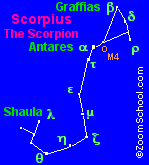 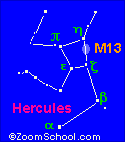 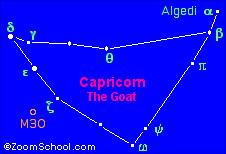 Have you ever stared at the clouds and tried to see pictures in them? Well, this is very similar to how ancient astronomers named the constellations. Constellations are groups of stars, and today there are 88 officially recognized constellations. Each is named for a figure or object that astronomers saw when they viewed the star group. Most of the constellations are named after characters in mythology. Hercules, Draco, Orion, and The Great Bear are just a few. Others are named after the signs of the zodiac, like Sagittarius, Capricorn, and Scorpios. But the way they were named is very similar. Just like we look at clouds today and see figures and other objects, the astronomers looked at the stars and saw things. But if you’ve ever played this cloud gazing game with your friends, you’ve probably noticed that different people see different things in the clouds. You may see a bear, while your best friend sees a lion in the very same cloud. This was also the case with naming the constellations. And as a result, the same constellation can be known by different names across the globe. One of the best-known constellations is the Big Dipper. If you’ve ever seen it in the sky, then you know it looks like a scooper or a dipper. But the ancient Greeks called the Big Dipper “Ursa Major” or “Big Bear”. The ancient Irish and French called the Big Dipper the “Chariot,” and the British referred to it as the “Plough”. So you can see how star gazing and studying the constellations to find shapes in the patterns can cause a single constellation to have multiple names. 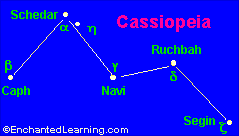 Another thing that contributes to these differing names is the expansion of the universe. The stars are moving and changing positions in the sky, which can make them, look less like what they were originally named and more like something completely different. The constellation Cassiopeia originally looked like a W, but today it appears to be a squiggly line. Astronomers believe that the Big Dipper will look like a number five in 50,000 years. Imagine what you will see the next time you look at the stars. Answer the questions: 1) What is a constellation? a) a group of stars that are close to Earth b) a group of stars that is named after a zodiac symbol c) a group of stars that was named for a figure or object that ancient astronomers saw d)a group of stars shaped like an unusual animal 2) How many officially recognized constellations are there? 3) Long ago, the constellation Cassiopeia was shaped like a W. Today it is shaped like a squiggly line. Why does it look different today than it did many years ago? 4) Complete each sentence below. a) The ancient Greeks thought the Big Dipper looked like a ___. b) Long ago, people of Britain thought the Big Dipper looked like a ___. c) Ancient Irish and French people thought the big dipper looked like a ___. Listening “It's a Zoo Up There in Space. Make That a Galaxy Zoo” Listen to the American radio program. This week, we tell about a project to identify images of one million galaxies that have been captured by the Sloan Digital Sky Survey. We also tell about the Perseid Meteor Shower. Complete the gaps: 1) NASA is observing Mars from orbit and also on its surface with the ___. 2) But there are objects in our solar system that remain mysterious. These are the asteroids and ___. 3) Astronomers believe that the force of gravity from ___ prevented the rocky material between it and Mars from forming a planet. 4) Ceres shares this classification with two other objects: Pluto and ___. 5) Astronomers believe that the outer covering of Ceres may contain up to twenty-five percent ___. 6) Vesta was the fourth object of its kind discovered. Astronomers believe it is covered with rock that melted and then became ___ again 7) Five percent of all meteorites we find on Earth might be from this one event on ___. 8) Dawn is a new kind of ___. 9) Dawn's engines use what is called an ion propulsion ___. 10) Dawn's eyes are two cameras that are exactly alike. They can measure light in seven different ___. 11) Researchers spend millions of dollars on equipment and tools they need to observe the ___. 12) The comet takes about ___ years to go around the sun, and leaves dust in its path. 13) People in big cities will be able to see the brightest meteors. But many, many more will be visible in the darkness of the countryside. The view this year will be especially good, because there will be very little ___. 14) Earth grazers are meteors that show up on the horizon and then trail overhead. A NASA official described them as “long, slow and ___.” 15) Professional astronomers have collected pictures of one million galaxies in our universe. These pictures came from a project called the Sloan Digital ___ Survey. 16) Astronomers want people around the world to help look at the pictures of the galaxies on a Web site and classify them into different kinds. All you need is a computer with connection to the Internet. This project is called ___. 17) Scientists say that knowing how many of each kind of galaxy there are will help them understand more about our universe. The information will help answer questions about how galaxies are made and how they ___. Unit 5 Planets and the Sun Start thinking! 1What planet is the closest to the Sun? 2 What planet is the largest in Solar System? 3 What planet is the farthest planet from the Sun? 4 Which one is called “red planet”? Label the Solar System Diagram: 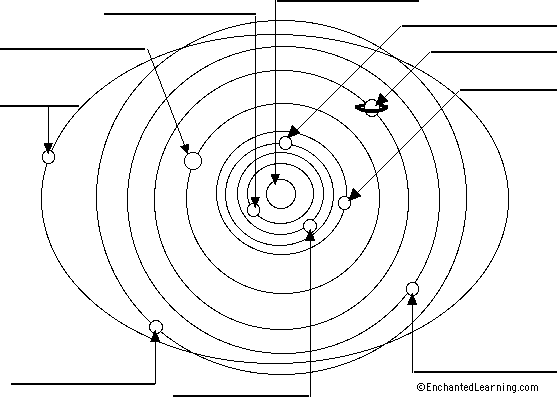 Reading 1 Read the article about planets and check your diagram. Text 5A Planets MERCURY: planet Closest to the Sun Temperature variations on Mercury are the most extreme in the solar system ranging from –170ғ C (–270ғ F 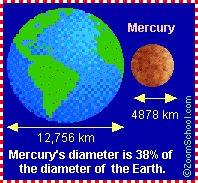 ) to 430ғ C (800ғ F). Mercury is the second smallest planet in the solar system. Only Pluto is smaller. Mercury is about the same size as our Moon. It is very close to the Sun. Mercury travels around the Sun faster than any other planet. It was named after Mercury, the swift messenger of the Roman gods. Mercury takes 59 days to make a rotation but only 88 days to circle the Sun. That means that there are fewer than 2 days in a year! Mercury can only be seen from Earth just before sunrise or just after sunset, but not in the middle of the night, because it always appears near the Sun. Mercury has a very thin atmosphere. The surface of Mercury has holes in it where objects such as meteorites and asteroids crashed into it. ) to 430ғ C (800ғ F). Mercury is the second smallest planet in the solar system. Only Pluto is smaller. Mercury is about the same size as our Moon. It is very close to the Sun. Mercury travels around the Sun faster than any other planet. It was named after Mercury, the swift messenger of the Roman gods. Mercury takes 59 days to make a rotation but only 88 days to circle the Sun. That means that there are fewer than 2 days in a year! Mercury can only be seen from Earth just before sunrise or just after sunset, but not in the middle of the night, because it always appears near the Sun. Mercury has a very thin atmosphere. The surface of Mercury has holes in it where objects such as meteorites and asteroids crashed into it.MARS: the red planet 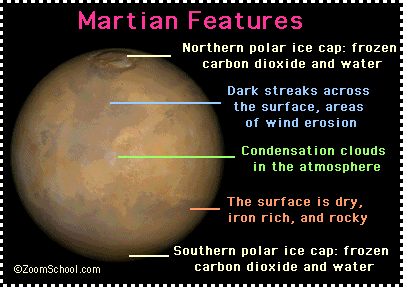 The temperature on Mars can be very, very cold. The iron is what gives Mars 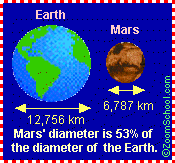 its red colour. Mars has many craters which were formed by meteorites or asteroids hitting it. Mars also has some of the deepest valleys in our solar system, and it is the home of Olympus Mons, the largest volcano found in the solar system. It stands about 27 kilometers high with a crater 81 kilometers wide. Mars has two moons, Phobos and Deimos. its red colour. Mars has many craters which were formed by meteorites or asteroids hitting it. Mars also has some of the deepest valleys in our solar system, and it is the home of Olympus Mons, the largest volcano found in the solar system. It stands about 27 kilometers high with a crater 81 kilometers wide. Mars has two moons, Phobos and Deimos.URANUS: Neptune's twin Uranus is one of the smaller gas giants in our solar system, but it is still large enough to hold 64 planets the size of Earth. Uranus’ axis is at a 97 degree angle, meaning that it orbits on its side! Uranus' atmosphere is made up of hydrogen, helium, and methane. It’s very cold. The cold methane gas is what gives Uranus its blue-green color. Uranus has eleven known rings. Uranus has 18 known moons. Some of these moons are less than 90 miles wide and black as coal. VENUS: Earth's Twin Venus is the second planet from the Sun. Venus and Earth are similar in size, composition, and mass. Its t 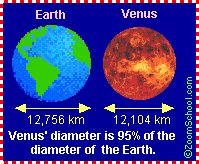 emperature during the day reaches 484 degrees Celsius. It’s so hot it could melt lead cannonballs. The dense atmosphere is composed of carbon dioxide and sulphuric acid, which acts as a greenhouse. Venus is usually visible with the naked eye. Venus is sometimes called the "morning star" or the "evening star." It’s the brightest "star" in the sky. That’s the reason why the ancient people called it Venus, the Roman goddess of love and beauty. Venus is the closest planet to Earth, but it does not have oceans or human life like Earth. The surface of Venus has many craters which were made by meteorites and asteroids crashing into the planet. Venus also has volcanoes. This planet is unusual because it rotates in a direction opposite that of all of the other planets. Venus spins very slowly as it orbits the Sun. A rotation takes 243 Earth days and its orbit takes 225 Earth days, so a Venusian day is longer than a Venusian year. emperature during the day reaches 484 degrees Celsius. It’s so hot it could melt lead cannonballs. The dense atmosphere is composed of carbon dioxide and sulphuric acid, which acts as a greenhouse. Venus is usually visible with the naked eye. Venus is sometimes called the "morning star" or the "evening star." It’s the brightest "star" in the sky. That’s the reason why the ancient people called it Venus, the Roman goddess of love and beauty. Venus is the closest planet to Earth, but it does not have oceans or human life like Earth. The surface of Venus has many craters which were made by meteorites and asteroids crashing into the planet. Venus also has volcanoes. This planet is unusual because it rotates in a direction opposite that of all of the other planets. Venus spins very slowly as it orbits the Sun. A rotation takes 243 Earth days and its orbit takes 225 Earth days, so a Venusian day is longer than a Venusian year.J 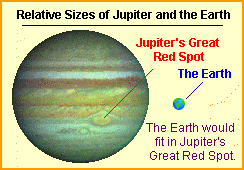 UPITER: the largest planet UPITER: the largest planetJupiter is the largest planet in the solar system. It is so large that all of the other planets in the solar system could fit inside of it. Jupiter is a large gas planet whose clouds change colours daily. A day on Jupiter lasts only 9 hours and 55 minutes. This planet is made mostly of hydrogen and helium gases. Jupiter gives off two times more heat than it gets from the Sun. It shines very brightly in the night sky for nine months of the year when it is closest to Earth. Jupiter has sixteen known moons. One of Jupiter's moons, Io, has active volcanoes on it. NEPTUNE: the blue Planet One Neptune year lasts 165 Earth years! It is so cold on Neptune that you would need skin thicker t 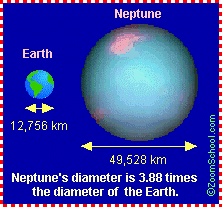 han a polar bear's to stay warm. Like Uranus, it is a large gas planet that looks like a big blue-green ball in the sky. Neptune has winds in its atmosphere which blow at over 2000 kilometres per hour! Neptune has two thick and two thin rings. Neptune also has eight moons. Four of these moons orbit the planet within the rings. One of Neptune's moons, Triton, orbits the planet in a direction opposite that of the seven other moons. Pluto has got an unusual elliptical shaped orbit, for this reason Neptune can be the farthest planet from the Sun for a 20 year period out of every 248 Earth years. han a polar bear's to stay warm. Like Uranus, it is a large gas planet that looks like a big blue-green ball in the sky. Neptune has winds in its atmosphere which blow at over 2000 kilometres per hour! Neptune has two thick and two thin rings. Neptune also has eight moons. Four of these moons orbit the planet within the rings. One of Neptune's moons, Triton, orbits the planet in a direction opposite that of the seven other moons. Pluto has got an unusual elliptical shaped orbit, for this reason Neptune can be the farthest planet from the Sun for a 20 year period out of every 248 Earth years.EARTH: the water Planet S 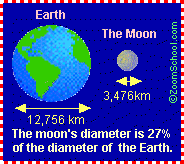 eventy percent of the Earth's surface is covered by water. The remaining 30 percent is covered by mountains, volcanoes, deserts, plains, and valleys Earth is the third closest planet to the Sun. It has an atmosphere made up of many different gases, but mainly it is nitrogen and oxygen. The atmosphere gives us air to breathe. We live on the planet Earth. The Earth orbits around the Sun. It takes one year to orbit the Sun. The Earth also rotates, or spins, on its axis. It takes one day to spin around one complete time. The Earth's axis is not straight up and down, but tilted a little bit. This tilt is responsible for us having seasons. Otherwise, the temperature would be the same all year long. eventy percent of the Earth's surface is covered by water. The remaining 30 percent is covered by mountains, volcanoes, deserts, plains, and valleys Earth is the third closest planet to the Sun. It has an atmosphere made up of many different gases, but mainly it is nitrogen and oxygen. The atmosphere gives us air to breathe. We live on the planet Earth. The Earth orbits around the Sun. It takes one year to orbit the Sun. The Earth also rotates, or spins, on its axis. It takes one day to spin around one complete time. The Earth's axis is not straight up and down, but tilted a little bit. This tilt is responsible for us having seasons. Otherwise, the temperature would be the same all year long. SATURN: the ringed Planet S 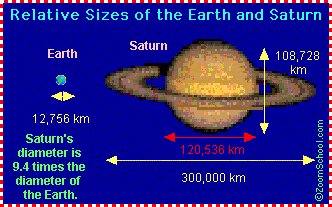 aturn is the second biggest planet, but it’s also the lightest planet. If there was a bathtub big enough to hold Saturn, it would float in the water! It looks like a big ball inside of rings. Saturn's atmosphere has winds which can blow at over 1800 kilometers per hour! The white spots on Saturn are powerful storms. Saturn is surrounded by over 1000 rings made of ice and dust. Some of the rings are very thin and some are very thick. The size of the particles in the rings ranges from pebble-size to house-size. Saturn has at least 18 known moons. Some of these moons orbit the planet within the rings. aturn is the second biggest planet, but it’s also the lightest planet. If there was a bathtub big enough to hold Saturn, it would float in the water! It looks like a big ball inside of rings. Saturn's atmosphere has winds which can blow at over 1800 kilometers per hour! The white spots on Saturn are powerful storms. Saturn is surrounded by over 1000 rings made of ice and dust. Some of the rings are very thin and some are very thick. The size of the particles in the rings ranges from pebble-size to house-size. Saturn has at least 18 known moons. Some of these moons orbit the planet within the rings.PLUTO: the ice planet P 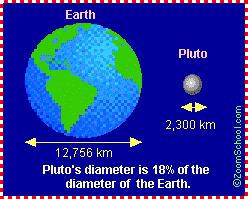 luto is smaller than one of Neptune's moons; Triton Pluto is usually the farthest known planet from the Sun. It has a very unusual orbit. Once every 248 Earth years, Pluto swings inside the orbit of Neptune. It stays there for twenty years. During those twenty years, Pluto is nearer to the Sun than Neptune. While it is nearer to the Sun, Pluto has an atmosphere. The methane and nitrogen frozen at the poles form an atmosphere. Pluto has only one known moon. Pluto's moon, Charon, is half the size of Pluto. luto is smaller than one of Neptune's moons; Triton Pluto is usually the farthest known planet from the Sun. It has a very unusual orbit. Once every 248 Earth years, Pluto swings inside the orbit of Neptune. It stays there for twenty years. During those twenty years, Pluto is nearer to the Sun than Neptune. While it is nearer to the Sun, Pluto has an atmosphere. The methane and nitrogen frozen at the poles form an atmosphere. Pluto has only one known moon. Pluto's moon, Charon, is half the size of Pluto. Name the planet: 1) Seventy percent of the planet’s surface is covered by water. 2) This planet is the second smallest planet in the solar system. 3) This planet is surrounded by over 1000 rings made of ice and dust. 4) One year on this planet lasts 165 Earth years! 5) This is the largest planet in the solar system 6) Atmosphere of this planet is made up of hydrogen, helium, and methane. 7) This planet has many craters which were formed by meteorites or asteroids hitting it. 8) The dense atmosphere of this planet is composed of carbon dioxide and sulphuric acid, which acts as a greenhouse. 9) This planet has only one known moon, Charon, which is half the size of planet. Answer the questions: 1) Which planet is the closest to the Sun? 2) Which planet is the largest in Solar System? 3) What is the second largest planet? 4) What is the third planet from the Sun? 5) Which planet lies between Earth and an asteroid belt? 6) What planet is even smaller than Mercury? 7) What planet is called Earth's twin because it is about the same size as Earth? 8) Which planet is the farthest planet from the Sun? 9) Which planet has rings and is about the same size as Neptune? Crossword “Solar System”  Across 1 The kind of planet that Earth and Mars are. 6 Star at the center of our solar system. 9 This planet is known as the red planet. 10 A hole in the ground caused by a meteor hitting a planet. 13 An outer layer of gas on a terrestrial planet. 15 Planet between Saturn and Neptune. 17 Planets like Jupiter, Saturn, Uranus, and Neptune. 20 A rock that crashes into Earth's atmosphere. 21 The largest planet in the solar system Down 2 Something that both Saturn and Uranus have. 3 Our planet. 4 An instrument that scientists use to observe planets. 5 Our galaxy. 6 Our sun is this. 7 This used to be called a planet until recently. 8 Planet closest to the sun. 11 Planet named after the sea god 12 Planet known as the evening star. 14 The path that a planet takes around the sun. 16 One of many 'rocks' in a belt between Mars and Jupiter. 17 The force that holds planets in their orbits. 18 Planet famous for its rings. 19 An icy rock that has bright tail when it comes close to the sun. 20 Earth's natural satellite. Text 5B The Sun Our sun is a star located at the center of our Solar System. It is a huge, spinning ball of hot gas and nuclear reactions that lights up the Earth and provides us with heat. The sun'sabsolute magnitude (its intrinsic brightness) is +4.83. Its stellar type is G (a star that absorbs strong metallic lines in its spectrum). The Greeks called the Sun "Helios"; the Romans called it "Sol." Our sun is a medium-sized yellow star that is 93,026,724 miles (149,680,000 km or 1 Astronomical Unit) from the E 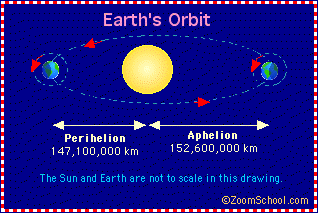 arth. arth.The Earth is closest to the Sun (this is called perihelion) around January 2 each year (91.4 million miles = 147.1 million km); it is farthest away from the Sun (this is called aphelion) around July 2 each year (94.8 million miles = 152.6 million km). The Sun's core can reach 10 to 22.5 million°F. The surface temperature is approximately 9,900°F (5,500°C). The outer atmosphere of the Sun (which we can see during a solar eclipse) gets extremely hot again, up to 1.5 to 2 million degrees. At the center of big sunspots the temperature can be as low as 7300 °F (4300 K, 4000 °C). The temperature of the Sun is determined by measuring how much energy (both heat and light) it emits. The Sun is made up of about 2 x 1030 kilograms of gas. It is composed of about 75% hydrogen and 25% helium. About 0.1% is metals (made from hydrogen via nuclear fusion). This ratio is changing over time (very slowly), as the nuclear reactions continue, converting smaller atoms into more massive ones. Since the Sun formed 4.5 billion years ago, it has used up about half of its initial hydrogen supply. Our Sun is a second or third generation star. Second generation stars do not just burn hydrogen, they also burn heavier elements, like helium and metals (elements heavier than hydrogen and helium), and were formed from supernova explosions (the debris of exploded population II stars). The element helium was named after the Sun (called "Helios" in Greek) because it was first discovered on the Sun. Helium is plentiful on the Sun but rare on Earth. The element helium was discovered by Jules Janssen during the total solar eclipse of 1868 when he detected a new line in the solar absorption spectrum; Norman Lockyer suggested the name helium. T 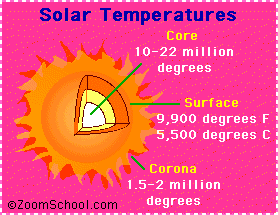 he composition of the Sun is studied using spectroscopy in which the visible light (the spectrum) of the Sun is studied. At the Sun's core, nuclear fusion produces enormous amounts of energy, through the process of converting hydrogen nuclei into helium nuclei (nuclear fusion). he composition of the Sun is studied using spectroscopy in which the visible light (the spectrum) of the Sun is studied. At the Sun's core, nuclear fusion produces enormous amounts of energy, through the process of converting hydrogen nuclei into helium nuclei (nuclear fusion).Although the nuclear output of the sun is not entirely consistent, each second the Sun converts about 600,000,000 tons of hydrogen nuclei into helium nuclei. These fusion reactions convert part of these atoms' mass (roughly 4 million tons) into energy, and release an enormous amount of this heat and light energy into the Solar System. In these fusion reactions, the Sun loses 4 million tons of mass each second. The Sun will run out of fuel in about 5 billion (5,000,000,000) years. When this happens, the Sun will explode into a planetary nebula, a giant shell of gas that will destroy the planets in the Solar System (including Earth). The Sun formed 4.5 billion years ago, as the solar system coalesced from a cloud of gas and dust. Astronomers study the Sun using special instruments. Scientists analyze how and why the amount of light from the Sun varies over time, the effect of the Sun's light on the Earth's climate, spectral lines, the Sun's magnetic field, the solar wind, and many other solar phenomena. The outer regions of the Sun (the corona) are studied during solar eclipses. Never look directly at the sun! Looking at the Sun can blind you or cause cataracts. The Ulysses spacecraft, a joint mission of the European Space Agency (ESA) and the National Aeronautics and Space Administration (NASA), was launched from the space shuttle on October, 1990 to explore the sun. It has studied the sun's magnetism, solar prominences and coronal mass ejections (orbiting over the south pole of the Sun in 1994 and over the North Pole in 1995), and will complete a second solar orbit in December, 2001. Answer the questions: 1) Is the Sun a star, a planet, or a nebula? 2) Is the Sun solid, liquid, or gaseous? 3) During what month is the Sun closest to the Earth? 4) Where is the Sun hottest? 5) Where is the Sun coolest? 6) What element is most plentiful on the Sun? 7) What element was named after the Sun? 8) What is the primary atomic reaction that occurs within the Sun that converts hydrogen atoms into helium atoms? 9) How old is the Sun? 10) Are sunspots hotter or colder than the surrounding areas? Listening “A Direct Look at Five Planets Far From Our Solar System” We are going to listen about planets orbiting stars other than the Sun, remember a huge disaster that struck four years ago and tell how someone you never met can make you happy. For questions 1-9 complete the sentence: 1) Last month, three teams of astronomers reported making direct images of planets orbiting other ___. 2) Today, more than ___ planets have been discovered beyond our solar system. 3) Some planets have been found because they pass ___ the stars they orbit. 4) One team was led by Christian Marois, an astronomer at the Herzberg Institute of Astrophysics in Victoria, Canada. His group found three planets orbiting a star called HR ___. 5) The team used the Keck Two and Gemini telescopes in Hawaii to produce the image showing the planets. The scientists also used a special technology called adaptive ___. 6) Bruce Macintosh of Lawrence Livermore National Laboratory helped make the discoveries. He says all three objects orbit their star in the same direction and plane -- the ___ planets do. 7) A second team announced the discovery of one planet orbiting the star Fomalhaut. Fomalhaut is the ___ brightest star in the sky. 8) Ann-Marie Lagrange of the University of Grenoble led a team that used the Very Large Telescope operated by the European Southern Observatory in Chile. The astronomers found the planet orbiting Beta Pictoris, a star ___ light years away. 9) A team in Thailand reported finding evidence of a tsunami striking that country a few centuries ago. Kruawun Jankaew works at Chulalongkorn University. Her team found sand material that represents a tsunami from ___ to ___ years ago. Writing workshop idea You have learned many things about space. You will be taking a space trip. Write a story about your journey into space. What did you see on take-off? How did it make you feel? Where did you go? What did you see while you were there? Are you returning to Earth with a friend or a souvenir? Did you miss your home planet? Book report questions: My planet is _____________________. 1 How big is your planet? 2 How many planets is it away from the sun? 3 What is your planet's distance from the earth? 4 Does your planet have any atmosphere? 5 Does your planet have any gravity? 6 Does your planet have any bands or rings? 7 How long does it take for your planet to revolve? 8 How long does it take your planet to rotate? 9 What is your planet's temperature? 10 What planets are on either side of your planet? 11. Tell something interesting that you learned about your planet that you never knew. Unit 6 Asteroids and Comets 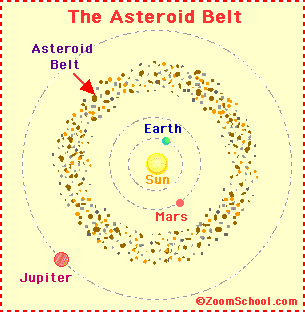 Text 6A Text 6AAsteroids Asteroids are rocky or metallic objects, most of which orbit the Sun in the asteroid belt between Mars and Jupiter. A few asteroids approach the Sun more closely. None of the asteroids have atmospheres. The asteroid belt is a doughnut-shaped concentration of asteroids orbiting the Sun between the orbits of Mars and Jupiter, closer to the orbit of Mars. Most asteroids orbit from between 186 million to 370 million miles (300 million to 600 million km or 2 to 4 AU) from the Sun. The asteroids in the asteroid belt have a slightly elliptical orbit. The time for one revolution around the Sun varies from about three to six Earth years. The strong gravitational force of the planet Jupiter shepherds the asteroid belt, pulling the asteroids away from the Sun, keeping them from careening into the inner planets. The asteroid belt is not smooth; there are concentric gaps in it (known as Kirkwood gaps). These gaps are orbital radii where the gravitational forces from Jupiter do not let asteroids orbit (they would be pulled towards Jupiter). For example, an orbit in which an asteroid orbited the Sun exactly three times for each Jovian orbit would experience great gravitational forces each orbit, and would soon be pulled out of that orbit. There is a gap at 3.28 AU (which corresponds to 1/2 of Jupiter's period), another at 2.50 AU (which corresponds to 1/3 of Jupiter's period), etc. The Kirkwood gaps are named for Daniel Kirkwood who discovered them in 1866. There are about 40,000 known asteroids that are over 0.5 miles (1 km) in diameter in the asteroid belt. About 3,000 asteroids have been cataloged. There are many smaller asteroids. The first one discovered (and the biggest) is named Ceres; it was discovered in 1801. Asteroids range in size from tiny pebbles to about 578 miles (930 kilometers) in diameter (Ceres). Sixteen of the 3,000 known asteroids are over 150 miles (240 km) in diameter. Some asteroids even have orbiting moons. Ceres is the largest of the asteroids. It was the first asteroid ever discovered (by the Italian astronomer Giuseppe Piazzi on January 1, 1801). Ceres is the size of the state of Texas! It is so huge in comparison with the other asteroids that its mass is equal to over one-third of the 2.3 x 1021 kg estimated total mass of all the 3,000 cataloged asteroids. Ceres is about 578 miles (930 kilometers) in diameter. Ceres is now considered to be a dwarf planet. Asteroids can be pulled out of their solar orbit by the gravitational pull of a planet. They would then orbit that planet instead of orbiting the Sun. Astronomers theorize that the two moons of Mars, Phobos and Deimos, are captured asteroids. The asteroid belt may be material that never coalesced into a planet, perhaps because its mass was too small; the total mass of all the asteroids is only a small fraction of that of our Moon. The total mass of all the asteroids is about 2.3 x 1021 kg ); our moon's mass is 7.35 x 1022 kg; the asteroids' mass combined is about 1/30 of the mass of the Moon. A less satisfactory explanation of the origin of the asteroid belt is that it may have once been a planet that was fragmented by a collision with a huge comet. Trojan asteroids are asteroids that orbit in gravitationally stable Lagrangepoints in a planet's orbit, either trailing it or preceding it (these places are where the gravitational attraction of the Sun and of the planet balances each other). Jupiter has the most Trojan asteroids; Mars also has some. Achilles was the first Trojan asteroid found. The asteroids preceding Jupiter in its orbit were named for Greek heroes; those following Jupiter in its orbit were named for Trojan heroes. Answer the questions: 1) The asteroid belt orbits between two planets ___ and ___. 2 Are all the asteroids in the asteroid belt? 3) Are asteroids bigger or smaller than planets? 4) What are asteroids composed of? 5) What may have caused the mass extinction on Earth 65 million years ago (the extinction that killed the dinosaurs)? 6) Name another group of organisms that went extinct during this mass extinction. 7) What is the name of the biggest asteroid (and the first one discovered)? 8) What is another name for asteroids? 9) Do any of the asteroids have a moon orbiting them? 10) Is the number of known asteroids over 0.5 miles (about 1 km) in diameter closest to: 40; 400; 4,000; 40,000 or 400,000? Asteroid: Cloze Activity Fill in the blanks below Word Bank:
Asteroids are rocky or metallic objects, most of which orbit the ___ in the asteroid belt between the planets ___and Jupiter. A few asteroids approach the Sun more closely. Asteroids are also known as ___ or minor planets. The first ___discovered (and the biggest) is named Ceres; it was discovered in 1801. About 3,000 asteroids have been cataloged. Asteroids range in size from tiny pebbles to about 578 miles (930 kilometers) in diameter (Ceres). There are about 40,000 known asteroids that are over about 0.5 miles (1 ___) in diameter in the asteroid belt. Sixteen of the 3,000 known asteroids are over 150 miles (240 km) in diameter. There are many smaller asteroids. Some large asteroids even have orbiting ___. None of the asteroids have ___. The asteroid ___ is a doughnut-shaped concentration of asteroids that orbit the Sun between the orbits of Mars and Jupiter, closer to the orbit of Mars. Most asteroids orbit from between 186 million to 370 million miles (300 million to 600 million km or 2 to 4 AU) from the Sun. The asteroids in the asteroid belt have a slightly elliptical ___. The time for one revolution around the Sun varies from about three to six Earth ___. The strong ___ force of the planet Jupiter shepherds (guides) the asteroid belt, pulling the asteroids away from the Sun, keeping them from falling into the inner planets. The asteroid belt is not smooth; there are concentric ___ in it (known as Kirkwood gaps). These gaps are orbits where the gravitational forces from Jupiter do not let asteroids orbit (if there were asteroids there, they would be pulled towards Jupiter). The ___ gaps are named for Daniel Kirkwood who discovered them in 1866. The asteroid belt may be material that never ___ into a planet, perhaps because it’s mass was too small; the total mass of all the asteroids is only a small fraction of that of the Earth's ___. A less satisfactory explanation of the origin of the asteroid belt is that it may have once been a planet that was fragmented by a collision with a huge comet. Text 6B Comets A comet is a small, icy celestial body that orbits around the sun. It is made up of a nucleus (solid, frozen ice, gas and dust), a gaseous coma (water vapor, CO2, and other gases) and a long tail (made of dust and ionized gases). The tail develops when the comet is near the Sun. Its long ion tail always points away from the sun, because of the force of the solar wind. The tail can be up to 250 million km long, and is most of what we see. Comets are only visible when they're near the sun in their highly eccentric orbits. 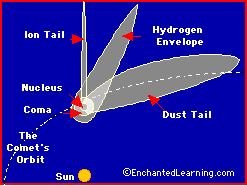 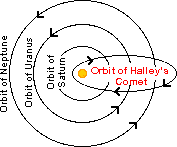 |
